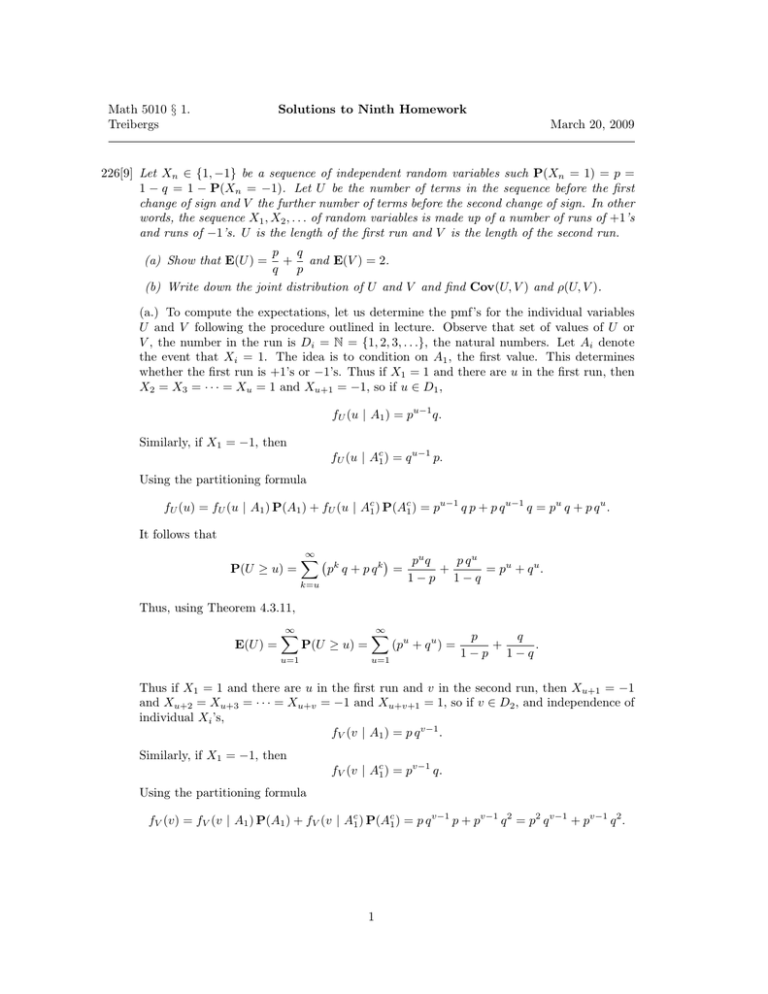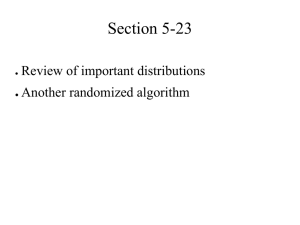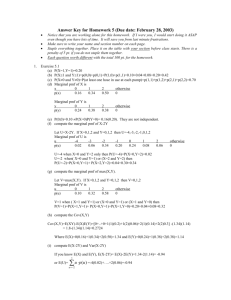Math 5010 § 1. Solutions to Ninth Homework Treibergs March 20, 2009
advertisement

Math 5010 § 1.
Treibergs
Solutions to Ninth Homework
March 20, 2009
226[9] Let Xn ∈ {1, −1} be a sequence of independent random variables such P(Xn = 1) = p =
1 − q = 1 − P(Xn = −1). Let U be the number of terms in the sequence before the first
change of sign and V the further number of terms before the second change of sign. In other
words, the sequence X1 , X2 , . . . of random variables is made up of a number of runs of +1’s
and runs of −1’s. U is the length of the first run and V is the length of the second run.
p q
+ and E(V ) = 2.
q
p
(b) Write down the joint distribution of U and V and find Cov(U, V ) and ρ(U, V ).
(a) Show that E(U ) =
(a.) To compute the expectations, let us determine the pmf’s for the individual variables
U and V following the procedure outlined in lecture. Observe that set of values of U or
V , the number in the run is Di = N = {1, 2, 3, . . .}, the natural numbers. Let Ai denote
the event that Xi = 1. The idea is to condition on A1 , the first value. This determines
whether the first run is +1’s or −1’s. Thus if X1 = 1 and there are u in the first run, then
X2 = X3 = · · · = Xu = 1 and Xu+1 = −1, so if u ∈ D1 ,
fU (u | A1 ) = pu−1 q.
Similarly, if X1 = −1, then
fU (u | Ac1 ) = q u−1 p.
Using the partitioning formula
fU (u) = fU (u | A1 ) P(A1 ) + fU (u | Ac1 ) P(Ac1 ) = pu−1 q p + p q u−1 q = pu q + p q u .
It follows that
P(U ≥ u) =
∞
X
k=u
p qu
pu q
+
= pu + q u .
pk q + p q k =
1−p 1−q
Thus, using Theorem 4.3.11,
E(U ) =
∞
X
P(U ≥ u) =
u=1
∞
X
(pu + q u ) =
u=1
p
q
+
.
1−p 1−q
Thus if X1 = 1 and there are u in the first run and v in the second run, then Xu+1 = −1
and Xu+2 = Xu+3 = · · · = Xu+v = −1 and Xu+v+1 = 1, so if v ∈ D2 , and independence of
individual Xi ’s,
fV (v | A1 ) = p q v−1 .
Similarly, if X1 = −1, then
fV (v | Ac1 ) = pv−1 q.
Using the partitioning formula
fV (v) = fV (v | A1 ) P(A1 ) + fV (v | Ac1 ) P(Ac1 ) = p q v−1 p + pv−1 q 2 = p2 q v−1 + pv−1 q 2 .
1
Here is an alternative way to compute the expectation. These formulas involve for |z| < 1,
!
∞
∞
X
d
1
1
d X k
k−1
;
z
=
=
kz
=
dz
dz 1 − z
(1 − z)2
k=0
k=1
!
∞
∞
∞
X
X
X
1
d2
2 k−1
k+1
k−1
(1)
k z
z
=
−
[(k + 1)k − k]z
= 2
dz
(1 − z)2
k=1
k=−1
k=1
d2
1
2
1
1+z
1
= 2
=
−
=
.
−
dz
1−z
(1 − z)2
(1 − z)3
(1 − z)2
(1 − z)3
Thus, using (1),
E(V ) =
X
v fV (v) =
v∈D2
∞
X
2
=p
∞
X
v p2 q v−1 + pv−1 q 2
v=1
∞
X
2
vq v−1 + q
v=0
vpv−1 =
v=0
p2
q2
+
= 2.
(1 − q)2
(1 − p)2
(b.) The joint probability is also gotten by conditioning on A1 . Let (u, v) ∈ D1 × D2 and
f (u, v) = P(U = u and V = v). Thus if X1 = 1 and the length of the first run is u and the
length of the second run is v, then X2 = · · · = Xu = 1, Xu+1 = Xu+2 = · · · = Xu+v = −1
and Xu+v+1 = 1, so if v ∈ D2 , and independence of individual Xi ’s,
f (u, v | A1 ) = pu−1 q v p = pu q v .
Similarly, if X1 = −1, then
f (u, v | Ac1 ) = q u−1 pv q = pv q u .
Using the partitioning formula
f (u, v) = fV (u, v|A1 ) P(A1 ) + f (u, v|Ac1 ) P(Ac1 ) = pu q v p + pv q u q = pu+1 q v + pv q u+1 .
Let us check the marginal probabilities.
fU (u) =
X
f (u, v) =
v∈D2
X
fV (v) =
f (u, v) =
∞
X
v=1
∞
X
u+1 v
p
u=1
u∈D1
pu+1 q pq u+1
+
= pu q + pq u ;
pu+1 q v + pv q u+1 =
1−q
1−p
p2 q v
pv q 2
q + pv q u+1 =
+
= p2 q v−1 + pv−1 q 2 .
1−p 1−q
To compute the further expectations, using (1),
E(U 2 ) =
E(V 2 ) =
∞
X
u=1
∞
X
u2 fU (u) =
∞
X
u2 (pu q + pq u ) =
u=1
v 2 fV (v) =
v=1
∞ X
∞
X
E(U V ) =
u=1 v=1
∞
X
pq(1 + p) pq(1 + q)
p(1 + p) q(1 + q)
+
=
+
(1 − p)3
(1 − q)3
q2
p2
v 2 (p2 q v−1 + pv−1 q 2 ) =
v=1
uv f (u, v) =
∞ X
∞
X
p2 (1 + q) q 2 (1 + p)
1+q 1+p
+
=
+
3
3
(1 − q)
(1 − p)
p
q
uv(pu+1 q v + pv q u+1 ) =
u=1 v=1
2
p2 q + pq 2
1 1
= + .
(1 − p)2 (1 − q)2
q
p
The variances are
2
p(1 + p) q(1 + q)
p q
Var(U ) = E(U ) − E(U ) =
+
−
+
;
q2
p2
q
p
1+q 1+p
+
− 4;
Var(V ) = E(V 2 ) − E(V )2 =
p
q
1 1 2p 2q
p + q − 2p2 − 2q 2
Cov(U, V ) = E(U V ) − E(U ) E(V ) = + −
−
=
.
q
p
q
p
pq
2
2
The expressions may be simplified using
p2 + q 2 = p2 + 2pq + q 2 − 2pq = (p + q)2 − 2pq = 1 − 2pq;
2
2
p − q = (p + q)(p − q) = p − q.
The variance of U may be simplified using (2) and (3),
2
2
p + q2
p3 (p + q + p) + q 3 (p + q + q)
−
p2 q 2
pq
4
3
3
4
4
2 2
2p + p q + pq + 2q − p − 2p q − q 4
=
p2 q 2
(p4 − 2p2 q 2 + q 4 ) + pq(p2 + q 2 )
=
p2 q 2
(p2 − q 2 )2 + pq(p2 − 2pq + q 2 ) + 2p2 q 2
=
p2 q 2
(p − q)2
(p − q)2
=2+
+
.
pq
p2 q 2
Var(U ) =
The variance of V may be simplified
p + 2q 2p + q
pq + 2q 2 + 2p2 + pq − 4pq
+
−4=
p
q
pq
2(p − q)2
2pq + 2(p2 − 2pq + q 2 )
=2+
.
=
pq
pq
Var(V ) =
Thus Var(V ) < Var(U ) unless p = q = 12 .
The covariance may be simplified using (2)
Cov(U, V ) =
p + q − 2p2 − 2q 2
1 − 2(p2 + q 2 )
1 − 2(1 − 2pq)
4pq − 1
=
=
=
pq
pq
pq
pq
2
2
4pq − (p + q)
(p − q)
=−
.
=
pq
pq
The correlation coefficient is thus
ρ(U, V ) = p
Cov(U, V )
p
Var(U ) · Var(V )
= r
−(p − q)2
.
(p−q)2
2
2
2pq + (p − q) + pq
(2pq + 2(p − q) )
I doubt that the text’s answer is correct since neither variance has (p − q)2 as a factor.
3
(2)
(3)
226[25] Let X and Y be independent geometric variables so that for m ≥ 0,
fX (m) = P(X = m) = (1 − λ)λm ,
fY (m) = P(Y = m) = (1 − µ)µm ,
where 0 < λ, µ < 1.
(a) If λ 6= µ, show that
P(X + Y = n) =
(1 − λ)(1 − µ) n+1
λ
− µn+1 .
λ−µ
Find P(X = k | X + Y = n).
(b) Find the distribution of Z = X + Y if λ = µ, and show that in this case,
1
P(X = k | X + Y = n) =
.
n+1
These geometric rv’s are defined for m ∈ D = {0, 1, 2, . . .}. Since the variables are assumed
independent, their joint pmf is the product
f (x, y) = fX (x) fY (y) = (1 − λ) (1 − µ) λx µy .
(a.) The pmf of the sum of independent variables is given by the convolution formula
Theorem 5.4.11. We observe that the sum is a finite geometric sum.
fZ (z) =
=
z
X
x=0
z
X
fX (x) fY (z − x)
(1 − λ) (1 − µ) λx µz−x
x=0
= (1 − λ) (1 − µ) µz
z x
X
λ
x=0
= (1 − λ) (1 − µ) µz
= (1 − λ) (1 − µ)
1−
µ
z+1
λ
µ
λ
µ
z+1
1−
µz+1 − λ
µ−λ
.
Observing that x = k and x+y = n implies x = k and y = n−k, the conditional probability
is gotten using the usual formula for 0 ≤ k ≤ n,
P(X = k and Z = n)
P(X = k and Y = n − k)
=
P(Z = n)
P(Z = n)
k n−k
f (k, n − k)
λ µ
(λ − µ)
=
=
.
fZ (n)
λn+1 − µn+1
P(X = k | Z = n) =
(b.) In case λ = µ,
fZ (z) =
=
z
X
x=0
z
X
fX (x) fY (z − x)
(1 − λ)2 λx λz−x
x=0
= (z + 1) (1 − λ)2 λz .
4
The conditional probability is for 0 ≤ k ≤ n,
P(X = k and Z = n)
P(X = k and Y = n − k)
=
P(Z = n)
P(Z = n)
2 n
1
f (k, n − k)
(1 − λ) λ
=
=
=
.
fZ (n)
(n + 1) (1 − λ)2 λn
n+1
P(X = k | Z = n) =
[A.] Two cards are chosen at random without replacement from a standard deck. Let X denote
the number of kings and Y the number of clubs. Find the joint pmf f (x, y), Cov(X, Y ) and
ρ(X, Y ).
The sample
space Ω is the set of combinations of 52 cards taken two at a time. Thus
|Ω| = 52
2 = 1326. Both X and Y take values in Di = {0, 1, 2}. The pairs take values in
D1 × D2 . If X = x and Y = y then f (x, y) = P(X = x and Y = y). There are 52 − 16 = 36
cards that are neither kings nor clubs. If X = 0 and Y = 0 both cards are neither king nor
club. If instead Y = 1 then one card is a club that isn’t a king and the other is neither king
nor club. If also Y = 2 both cards are clubs but neither is a king.
36
36 · 35
105
12 · 36
12 · 36 · 2
72
2
=
,
f (0, 1) = 52 =
=
f (0, 0) = 52 =
52
·
51
221
52
·
51
221
2
2
12
12 · 11
11
2
=
=
f (0, 2) = 52
52
·
51
221
2
If X = 1 there is one king. For Y = 0 the king can’t be a club so there are three remaining
kings. The second card cannot be king nor club, so there are 36 choices. For Y = 1 there is
one king and one club. Either one card is the king of clubs and the other neither king nor
club or one is a non-club king and the other is a non-king club. If also Y = 2 then one of
the cards is a king of clubs and the other is another club so
f (1, 0) =
3 · 36
3 · 36 · 2
18
1 · 36 + 3 · 12
72 · 2
12
=
=
,
f (1, 1) =
=
=
,
52
52
52
·
51
221
52
·
51
221
2
2
12 · 2
2
1 · 12
=
f (1, 2) = 52 =
52
·
51
221
2
If X = 2 and Y = 0 both cards are kings but neither is the king of clubs. If instead Y = 1
then there are two kings, one being the king of clubs. If also Y = 2 then it is impossible
that both cards are kings and both cards are clubs.
3
3·2
1
3
3·2
1
2
f (2, 0) = 52 =
=
,
f (2, 1) = 52 =
=
,
f (2, 2) = 0.
52
·
51
442
52
·
51
442
2
2
The joint pmf is collected in Figure 1.
The marginal probabilities are the row and column sums of the joint pmf. For x ∈ D1 or
y ∈ D2 ,
X
X
fX (x) =
f (x, y);
fY (y) =
f (x, y).
y∈D2
x∈D1
The marginal probabilities are also given in Figure 1.
The variables X and Y are not independent, for example because
f (2, 2) = 0 6=
13
1
·
= fX (2)fY (2).
221 221
5
x=0
x=1
x=2
fY (y)
y=0
105
221
18
221
1
442
247
442
=
19
34
y=1
72
221
12
221
1
442
169
442
=
13
34
y=2
11
221
2
221
0
13
221
=
1
17
fX (x)
188
221
32
221
1
221
1
Figure 1: Table of joint pmf and marginal probabilities.
The expected values are
E(X) =
X
0 · 188 + 1 · 32 + 2 · 1
34
2
=
=
;
221
221
13
x fX (x) =
x∈D1
X
E(Y ) =
y fY (y) =
y∈D2
X
E(X 2 ) =
0 · 19 + 1 · 13 + 2 · 2
17
1
=
= ;
34
34
2
02 · 188 + 12 · 32 + 22 · 1
36
=
;
221
221
x2 fX (x) =
x∈D1
E(Y 2 ) =
X
02 · 19 + 12 · 13 + 22 · 2
21
=
;
34
34
y 2 fY (y) =
y∈D2
E(XY ) =
X
x y f (x, y) =
(x,y)∈D1 ×D2
34
1
1 · 1 · 24 + 1 · 2 · 4 + 2 · 1 · 1
=
=
.
442
442
13
The variances and covariances are from their computational formulas,
36
22
400
− 2 =
;
221 13
2873
2
25
21 1
− 2 =
;
Var(Y ) = E(Y 2 ) − E(Y )2 =
34 2
68
1
2 1
Cov(X, Y ) = E(XY ) − E(X) E(Y ) =
−
· = 0.
13 13 2
Var(X) = E(X 2 ) − E(X)2 =
Thus X and Y are uncorrelated, since the correlation coefficient is
Cov(X, Y )
p
= 0.
Var(X) Var(Y )
ρ(X, Y ) = p
6







